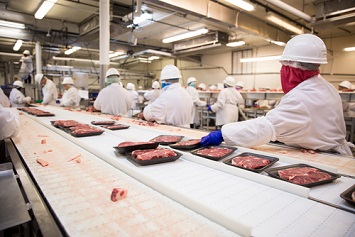The Centers for Disease Control and Prevention (CDC) and the Occupational Safety and Health Administration (OSHA) jointly issued interim guidance for meat- and poultry-processing facilities to protect workers during the ongoing COVID-19 pandemic.
CDC disease surveillance noted multiple COVID-19 outbreaks at U.S. meat- and poultry-processing facilities.
The interim guidance from the CDC and OSHA includes information about:
- Appropriate engineering, administrative, and work practice controls;
- Screening employees for the coronavirus before they enter work facilities; and
- Responding to workers who show symptoms of the coronavirus.
The CDC emphasized that workers in meat- and poultry-processing facilities are not exposed to SARS-CoV-2 through the meat products they handle. The CDC’s current understanding is that the virus is spread mainly from person to person due to close contact with one another (within about 6 feet) and through respiratory droplets produced when an infected person coughs, sneezes, or talks.
“OSHA’s newest guidance document outlines steps employers can take to provide a safe and healthy workplace for workers in the meatpacking and processing industries,” Principal Deputy Assistant Secretary of Labor for Occupational Safety and Health Loren Sweatt said in an agency statement.
Meat- and poultry-processing employers need to alter production practices to maintain appropriate distances among workers to prevent SARS-CoV-2 transmission. Employers should modify the alignment of workstations, including those on processing lines, so that workers are at least 6 feet apart in all directions (both across from each other and side by side). Workers ideally would not face one another. Employers should consider using markings and signs to remind workers to maintain social distancing both at their stations and on breaks.
Employers also can use physical barriers, such as plexiglass or similar material, strip curtains, or other impermeable dividers or partitions, to separate workers from each other.
If fans, such as pedestal fans or hard mounted fans, are used in the facility, employers should take steps to minimize air from fans blowing from one worker directly onto another. Personal cooling fans should be removed to reduce the potential spread of any airborne or aerosolized viruses.
However, if fans are removed, employers should remain aware of and take steps to prevent heat hazards.
Employers should encourage hand hygiene by placing hand-washing stations or hand sanitizer with at least 60% alcohol in multiple locations. If hand sanitizer stations are used, employers should choose ones that are touch-free.
Other steps could include adding clock-in/-out stations spaced apart to reduce crowding, staggering times for workers to clock in/out, or using alternative touch-free methods of clocking in/out.
Employers should reduce crowding in break areas by adding partitions to break room tables, identifying alternative areas for break accommodations such as conference or training rooms, removing or rearranging chairs and tables, or using outside tents for break and lunch areas.
Employers also should use administrative controls to promote social distancing, such as:
- Encouraging single-file movement with a 6-foot distance between each worker through the facility;
- Designating employees to monitor and facilitate distancing on processing floor lines; and
- Encouraging workers to avoid carpooling or wear cloth masks in shared van or car space and cleaning and disinfecting commonly touched surfaces in company shuttle buses or vans.
Employers should train workers in the signs and symptoms of COVID-19, as well as methods like cough and sneeze etiquette, hand-washing, and social distancing, to prevent coronavirus transmission. Employers must clean and disinfect tools and commonly touched surfaces using disinfectants with Environmental Protection Agency registrations that are effective for use against SARS-CoV-2.
Employers also may screen employees for COVID-19 symptoms using temperature checks to identify anyone with a fever of 100.4 degrees Fahrenheit or greater. However, employers must ensure screeners are trained to use temperature monitors and wear appropriate personal protective equipment.
Employers should not allow an employee with a suspected SARS-CoV-2 infection to enter the workplace. Sick employees should be encouraged to stay home and contact a healthcare provider. If a worker is confirmed to have COVID-19, employers should inform anyone the individual has come into contact with, including fellow workers, inspectors, and graders, of his or her possible exposure to COVID-19 in the workplace.

